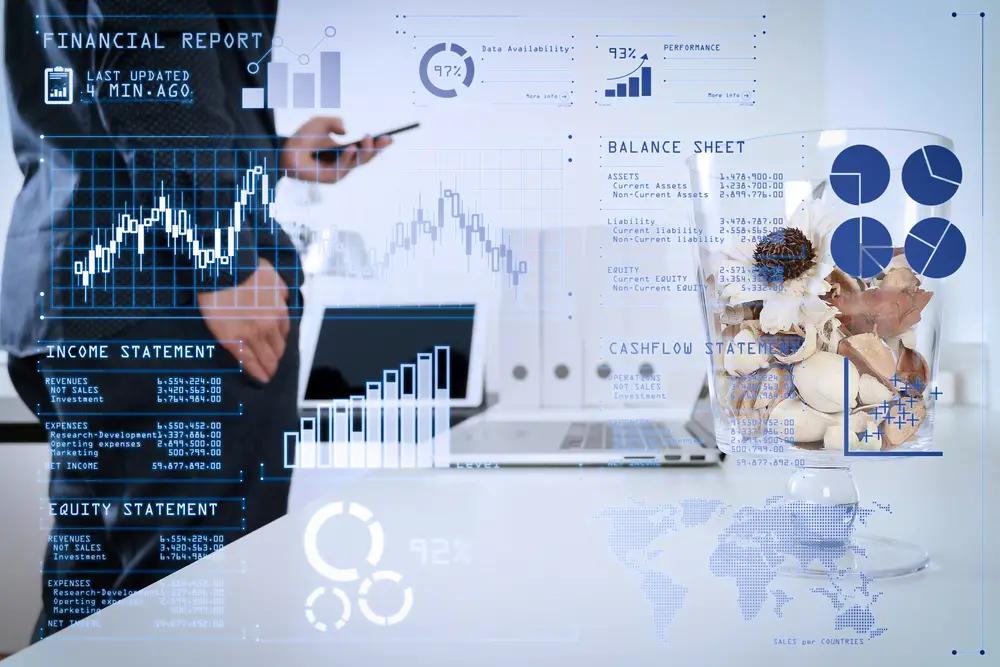Changes in interest rates can significantly impact a company’s profitability and financial stability. Therefore, it’s important to have Key Risk Indicators (KRIs) to help monitor and manage this risk.
An Interest Rate Key Risk Indicator could be the “Interest Rate Gap.” The interest rate gap is a measure of the mismatch between the interest rate sensitivity of a company’s assets and liabilities.
If a company’s assets are more sensitive to interest rate changes than its liabilities, it could face a risk if interest rates rise. Conversely, if a company’s liabilities are more sensitive, it could face a risk if interest rates fall.
Another Interest Rate KRI could be the “Duration Gap”. Duration is a measure of the sensitivity of a financial instrument’s price to changes in interest rates. The duration gap is the difference in duration between a company’s assets and liabilities.
A positive duration gap indicates that a company is more exposed to the risk of falling interest rates. In contrast, a negative duration gap indicates more exposure to the risk of rising interest rates.
These are just a couple of examples. The specific KRIs used will depend on the nature of the company’s operations and its exposure to interest rate risk. It’s also important to remember that KRIs are just one tool for managing risk. They should be used in conjunction with other risk management strategies and tools.
The interest rate KRI is essential for banks as it provides an early warning sign of potential challenges that could arise due to changes in interest rates. With constantly evolving market conditions and regulatory uncertainty, financial institutions must remain vigilant about risks that could impact their bottom line.
The interest rate KRI enables banks to make informed decisions on managing exposures, reducing risk levels, and improving operational efficiencies.
This article will explore the importance of the interest rate KRI and its role in enterprise risk management for financial institutions.

Examples of interest rate KRIs
Interest Rate Gap: This KRI measures the difference between the amount of a company’s assets and liabilities subject to interest rate changes. A large interest rate gap could indicate a high level of interest rate risk.
Duration Gap: This KRI measures the sensitivity of a company’s assets and liabilities to changes in interest rates. A large duration gap could indicate a high level of interest rate risk.
Net Interest Margin (NIM): This KRI measures the difference between the interest income a bank or other financial institution generates and the amount of interest paid out to their lenders relative to their interest-earning assets. It is a key measure of a bank’s profitability.
Loan-to-Deposit Ratio: This KRI measures a bank’s loans as a percentage of its deposits. A high loan-to-deposit ratio could indicate a high level of interest rate risk, as it may suggest that the bank heavily relies on short-term funding to finance long-term loans.
Fixed to Variable Rate Loan Ratio: This KRI measures the proportion of a bank’s loan portfolio comprising fixed-rate loans versus variable-rate loans. A high ratio could indicate a high level of interest rate risk, as the bank’s income from these loans would be more affected by changes in interest rates.
Yield Curve Slope: This KRI measures the difference in interest rates between short-term and long-term loans. A steep yield curve slope could indicate a high level of interest rate risk, as it suggests that long-term loans are much more expensive than short-term loans.
Credit-related KRIs
credit-related KRIs, such as loan defaults, delinquencies, and non-performing loans, are highly predictive in nature and play a critical role in assessing the potential risk exposure of a financial institution to credit risks.
These indicators provide early warning signs that can help banks assess and mitigate risks to their portfolios while lowering operational risks.
As such, credit-related KRIs are essential for bankers looking to anticipate economic trends and make informed decisions. Loan defaults refer to instances where borrowers fail to meet their repayment obligations, which can lead to significant losses for financial institutions.
Delinquencies occur when payments are missed or made past their due dates. Non-performing loans refer to loans that have stopped generating interest income or principal repayments for banks.
All three indicators predict how the economy will perform by measuring the ability of borrowers to service their debts.
Banks can develop risk mitigation plans that reduce threats to business objectives and improve their chances of success. These plans often involve allocating more resources toward employee training and implementing appropriate management processes.
Financial institutions can make educated guesses about upcoming economic trends while ensuring they remain within risk tolerance levels.
Operational KRIs
Operational KRIs are essential metrics used by financial institutions to monitor the performance of internal systems, controls, and procedures and to detect any inadequacies or failures that may result in operational risk.
This KRIs category helps banks identify potential risks arising from employee errors, fraud, third-party relationships, business interruption, hardware or software system failures, power outages, and telecommunications disruption.
Operational KRIs are critical because they help banks assess their ability to meet regulatory requirements while maintaining efficient operations. The number of operational losses and operational risk events are some examples of operational KRIs for banks.
However, it is important to note that these indicators should target the event’s root cause rather than just measuring something that has already happened.
Additionally, banks can use advanced features such as risk heat maps, which visually represent potential risks across different areas within an organization.
Tracking operational KRIs provides valuable insights into an institution’s day-to-day operations and helps identify areas where improvements can be made.
Market KRIs
Market key performance indicators (KPIs) provide financial institutions with crucial insights into the current market’s challenges, allowing them to make well-informed decisions and mitigate potential risks.
Market KRIs help identify problems that may cause losses in a bank’s trading book or its clients’ portfolios, such as changes in interest rates, exchange rates, or commodity prices.
Banks face this risk because they borrow funds at one rate and lend them out at another rate. A sudden change in interest rates can lead to a significant reduction in profits for banks. Therefore, tracking this KRI enables banks to anticipate market movements and take corrective actions before it affects their business operations.
Monitoring market KRIs allows financial institutions to avoid potential threats and make informed decisions based on current market conditions.
Tracking these metrics closely using data analytics tools like Microsoft Power BI or enterprise risk management software like ZenGRCs ERM solution, banks can minimize their exposure to risks and maximize opportunities for growth.
Compliance KRIs
Compliance key performance indicators (KPIs) are vital for financial institutions to ensure their compliance framework is robust, reliable, and effective, instilling confidence in their stakeholders and the public.
These KRIs help banks identify any weaknesses within their compliance program, including risks arising from regulatory changes or updates. It is essential for banks to have a strong compliance program as it not only maintains legal requirements but also helps mitigate reputational risks.
Compliance KRIs enable businesses to put their performance in context by making comparing their performance with peers easier. Data generated from compliance violations and corrective actions proves valuable for management as they can use it to make informed decisions regarding future initiatives.
Insurance companies also use these KRIs since keeping close track of them ensures that insurance companies never have trouble meeting all financial obligations while maintaining a healthy reputation.
Compliance KRIs play an integral role in ensuring that the banking industry operates within legal parameters while maintaining high standards of ethics and governance.
Monitoring these KRIs is fundamental for banks as it enables them to act proactively rather than reactively regarding potential threats or issues related to regulatory non-compliance.
Financial institutions must prioritize continuously monitoring and assessing these KRIs as part of their overall risk management strategy.

Role in Enterprise Risk Management
Effective use of key risk indicators is critical for financial institutions to implement a comprehensive enterprise risk management program to detect and mitigate potential threats, instilling confidence in stakeholders and safeguarding the institution’s reputation.
One area where KRIs are particularly important is interest rate risks. Banks face significant challenges in managing their exposure to this type of risk in today’s economy, with interest rates at historic lows. Interest rate KRIs can help banks monitor changes in market conditions and adjust their strategies accordingly.
To effectively manage interest rate risks, banks need to track a range of KRIs related to this type of risk. The most important indicators include net interest margin (NIM), duration gap analysis, sensitivity analysis, and liquidity ratios.
NIM measures the difference between a bank’s revenue from loans and its cost of funds; duration gap analysis helps assess how changes in interest rates may impact the value of assets versus liabilities; sensitivity analysis estimates how much a bank’s earnings or capital would be affected by changes in interest rates; while liquidity ratios help ensure that the bank has sufficient cash reserves to meet its obligations.
Overall, effective use of key risk indicators can help banks identify potential vulnerabilities before they become major problems. By tracking these metrics regularly and adjusting their strategies as needed, banks can improve their ability to manage risks associated with changing market conditions such as interest rates.
This helps protect against reputational damage and supports long-term growth by instilling confidence among stakeholders that banks are taking proactive steps to protect themselves against future risks.
Frequently Asked Questions
How do interest rates impact credit-related KRIs for banks?
Interest rates have a significant impact on credit-related KRIs for banks. Higher interest rates increase the cost of borrowing, leading to higher default and delinquency rates on loans. Lower interest rates stimulate demand for loans and decrease credit risk exposure.
What are some examples of fraud-related metrics under operational KRIs?
Fraud-related metrics under operational KRIs for banks include the number of detected incidents, the number of losses incurred, and the time taken to detect and respond to fraud. These indicators help mitigate employee errors, breaches, or external fraud risks.
How do market KRIs shed light on the biggest problems in the market?
Market KRIs provide insights into significant challenges affecting the current market. By tracking indicators such as unemployment statistics and analyzing customer behavior, banks can anticipate trends, identify potential risks, and make informed decisions to mitigate them.
How do compliance KRIs help businesses put their performance in context?
Compliance KRIs allow businesses to uncover weaknesses in their compliance framework, providing context to compare their performance with peers. Data from violations and corrective actions offer valuable insights for management decision-making.
How does using KRIs fit into a broader enterprise risk management strategy for mid-sized banks?
Using KRIs is an important part of a broader enterprise risk management strategy for mid-sized banks. It allows them to track trends, anticipate potential risks, and develop risk mitigation plans to reduce threats to business objectives and improve their chances of success.

Conclusion
The interest rate key risk indicator is crucial in helping banks manage risks and improve their chances of success. As financial institutions face various risks, from credit and operational risks to market challenges and regulatory uncertainty, monitoring KRIs provides an early warning sign that risk may impact the bank’s ability to succeed.
The interest rate KRI assesses rising interest rates’ risk and potential impact on a bank’s earnings and capital. Effective management of KRIs requires collaboration between different departments within a bank, including risk management, finance, compliance, and operations.
Using KRIs such as the interest rate KRI, banks can make informed decisions to mitigate risks proactively and optimize their operations for sustained growth. As such, it is essential for banks to prioritize the use of KRIs in their enterprise risk management framework to ensure they are well-positioned to navigate an ever-changing market landscape.

Chris Ekai is a Risk Management expert with over 10 years of experience in the field. He has a Master’s(MSc) degree in Risk Management from University of Portsmouth and is a CPA and Finance professional. He currently works as a Content Manager at Risk Publishing, writing about Enterprise Risk Management, Business Continuity Management and Project Management.

